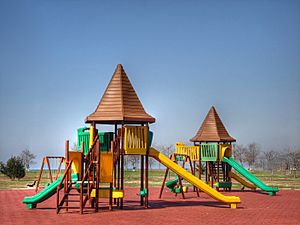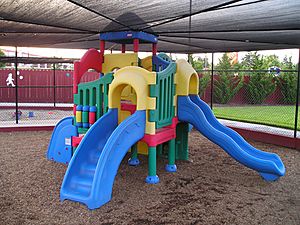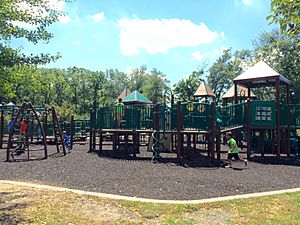Playgrounds facts for kids
A playground is a special place, usually outdoors, where children can play. While most playgrounds are for kids, some are made for other age groups, like the Preußenpark in Berlin, Germany, which is designed for people aged 70 or older! Some playgrounds might also have age limits for younger children.
Modern playgrounds often have fun equipment like seesaws, merry-go-rounds, swingsets, slides, jungle gyms, chin-up bars, sandboxes, and spring riders. Many of these help kids get stronger, more flexible, and better at moving their bodies. Playgrounds are also great for having fun, relaxing, and learning how to get along with others. Often, you'll find "play structures" that connect many different pieces of equipment together.
Sometimes, playgrounds also have areas for playing sports, like a baseball diamond, a skating area, a basketball court, or a tetherball pole. These are usually public places like parks or schools. In some parts of the United States, a playground for very young children might be called a tot lot. A special kind of playground called a playscape is designed to be a safe place for play in a natural setting.
Contents
How Playgrounds Started
For a long time, children mostly played in the streets and areas near their homes. But in the 1800s, thinkers like Friedrich Fröbel suggested that playgrounds could help children learn and grow. They believed playgrounds could teach kids about fair play and good manners.
The first public playground built just for play opened in a park in Manchester, England, in 1859. In the United States, one of the earliest playgrounds was built in San Francisco's Golden Gate Park in 1887. Later, groups like the Playground Association of America were formed to help create more playgrounds across the country.
After World War II, a landscape architect named Lady Allen of Hurtwood in London came up with the idea of "junk playgrounds." These playgrounds used recycled materials and rubble left over from the war. She wanted to create fun spaces for children living in the new tall buildings in British cities. Her ideas helped adventure playgrounds, which let children play freely and creatively, spread around the world.
Playgrounds in the Soviet Union
Playgrounds were a big part of city life in the USSR. In the 1970s and 1980s, almost every park in Soviet cities had a playground. The equipment was often similar across the country, usually made of metal with some wooden parts. Common items included carousels, seesaws, and structures shaped like rockets or bridges.
Designing Play Areas
Playground design depends on who will be using it. Sometimes, separate play areas are made for very young children. Large, open parks might not be used as much by older girls or quieter children, because it can be hard for them to find a quiet spot away from more active kids. But a park with many different play areas is often used equally by both boys and girls.
How Playgrounds Help Kids Grow
Experts agree that the social skills children learn on the playground can stay with them for life. Research shows that playgrounds are some of the most important places for children outside their homes. All kinds of play are important for healthy growth, but free, unplanned play—the kind that happens on playgrounds—is the most helpful.
Exciting and challenging playground equipment helps keep children happy while also helping them learn. Playgrounds should have different types of equipment for different ages and learning stages. For example, there can be special equipment for nursery and preschool children to teach them basic numbers and words. Other equipment, like role-play panels or puzzles, can help build a child's creativity and imagination.

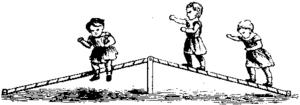
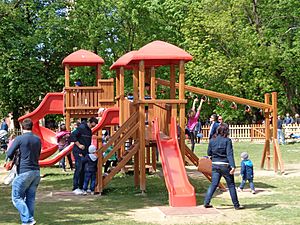
For many children, time on the playground during free time or recess is their favorite part of the day. It helps them relax from the pressures of learning. They know that playground time is their own time to explore and have fun. A playscape can give children a sense of ownership over their play space. Playscapes also help parents feel sure that their child is safe and well, which might not be as clear in an open field or wooded area.
Images for kids
-
A playground under construction in Ystad, Sweden in 2016
-
Playground at Käpylä sports park in Pasila, Helsinki, Finland
-
Playground in Yonkers, New York
-
The Royal Oak, Monmouth playground
-
Thematic playground with an agricultural machine
-
The Wonder World play area at the departure lounge of Suvarnabhumi International Airport, Bangkok
-
The playground at Fermilab includes a bubble chamber model and a path resembling that followed by protons in a collider
-
Jacques-Laurent Agasse: The Playground, 1830
-
A wooden castle at playground in Rakvere, Estonia
-
Playground in Ystad, Sweden in 2019. The colorful surface is soft rubber asphalt.
See also
 In Spanish: Espacio de recreación para niños
In Spanish: Espacio de recreación para niños


